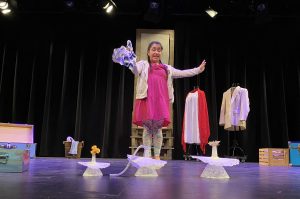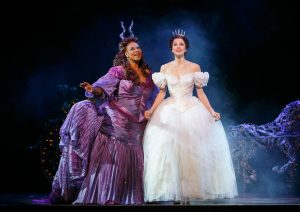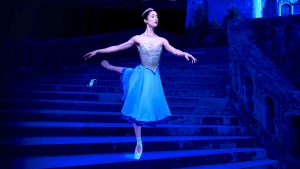Sometimes even the most beloved of fairy tales contain messages that appear “unmodern” on the surface, although upon closer scrutiny we often find reasons why they still resonate. The many Cinderella stories of the last several centuries seem to characterize a hapless woman who has to be “rescued” by a handsome prince: Yet even the earliest versions of this folk tale (some of which date back millennia) underscore virtues of grace, selflessness, and inner strength.

Madison Paloma will perform at Midwest Trust Center in Cenicienta, amidst an array of found objects she fashions into characters of the Cinderella story. / Photo by Chris Owen
“Beauty in a woman is a rare treasure that will always be admired,” wrote Charles Perrault, whose 1697 version (Cinderella, or: The Little Glass Slipper) has become the source for a number of retellings. “Graciousness, however, is priceless and of even greater value.”
This February, Kansas City audiences will be treated to two very different stage versions of the Cinderella story, as Midwest Trust Center presents Glass Half Full Theatre’s one-woman puppet show Cenicienta: A Bilingual Cinderella Story and the Kansas City Ballet presents Devon Carney’s new ballet, Cinderella. Each of these can inspire us to think about where we stand with this story, which deals with fundamental concepts of romance but also touches upon character and self-esteem.
“This is not your typical man-saves-the-day version of Cinderella,” said Kara Armstrong, Midwest Trust Center’s program director for arts education, of Cenicienta.“It’s more about finding your inner voice, and standing up for yourself.” Kara invited the Austin-based company after seeing a demonstration of Cenicienta at a conference, where she was immediately drawn to the imaginative use of “object puppetry.”

Caroline Reck
The story’s Belinda is a 10-year-old budding poet whose real-life stepmother has sent her to the basement to fold napkins for a party. Feeling a bit like a downtrodden Cinderella herself, she uses household items to tell her own version of the tale: Cenicienta is a wood-ringed cloth napkin and the Hada Madrina (Fairy Godmother) has an upside-down teapot for a head. The ancient tale is thus resuscitated “by focusing on the parts of the story that are still relevant or meaningful or empowering,” Kara said.
That it is bilingual and includes puppets permits it to resonate with a broad range of young audiences. “Even little kids can find this sort of ‘object play’ interesting and fun and silly,” said Caroline Reck, one of Glass Half Full’s artistic directors, who co-authored Cenicienta with Rupert Reyes. And older kids “can appreciate the coming-of-age, personal-growth story.”
Even in a one-woman show with 18 characters and 16 voices, the authors wanted to present the tale’s familiar elements. “We want you to see what you recognize: the prince and the love story and the ball,” Caroline said. “But we wanted to make sure there’s an overarching story about a girl’s personal growth toward her own artistic vision,” she added, “and to tell the story of Belinda realizing her value as a person.”
Cenicienta joins a variety of recent revisions of the tale, including Kay Cannon’s 2021 film musical starring Camila Cabello as an ambitious dressmaker, “Ella,” and Douglas Carter Beane’s Broadway revival of the Rodgers & Hammerstein musical, which appeared at Starlight Theatre as recently as 2018.

Kecia Lewis and Paige Faure performed at the Starlight Theatre’s 2015 performance of Rodgers & Hammerstein’s touring Cinderella, in Douglas Carter Beane’s adaptation. / Photo by Carol Rosegg
In Douglas’ version, Prince “Topher” is also an orphan: Having fallen under the influence of an evil Prime Minister, he feels unworthy to rule. Thus, he brings vulnerability to the ball, and he is impressed as much with Ella’s kindness and sensitivity as with her beauty. Later, as he explores his kingdom, he is determined to restore kindness and social justice.
“I wanted to make it a story that a young girl would see and go, ‘That’s the Prince I should be looking for,” Douglas said in 2015, when the production first came to Starlight. “I should be looking for a complicated guy who’s good… but needs a little help.” Likewise, he wanted boys to identify with the story and not feel as if they had to be some sort of wise, handsome superman. “I wanted little boys to look up at him and identify with him, like ‘I don’t feel perfect, either.’ ”
To be sure, the original Broadway musical of 1957 had already portrayed a young man apprehensive about having to meet a large assembly of eager young women. And even in the 1950 Disney film, the prince falls for the woman he finds the most interesting and who, not insignificantly, is the least calculating person at the ball. (How did Cinderella miss the important little fact that he’s a prince?)

Devon Carney / Photo by Brett Pruitt & East Market Studios
Both versions appearing here in February aim similarly to cast new light, even the Kansas City Ballet’s quintessentially classical take, which the company is presenting with its original Prokofiev score. “I’m a little bit more of a traditionist,” said Devon, who during his career as a dancer in Cinderella has performed everything from Trumpet Herald to Prince (and later, the Father).
“When you whittle it down, it’s a young girl who finds herself in a difficult, oppressive situation. There seems to be no way out until she discovers a friend, her Fairy Godmother, who gives her the chance to find her way. But she has to do a little work to make that happen.”
Devon’s Cinderella also has to trust her inner self: “She’s never been to a palace, so this is a big deal. And she carries herself with aplomb and confidence that can only come from trusting herself. … That’s who the Prince falls in love with.” While some versions of the Cinderella story tend toward the overly literal, dance’s non-verbal qualities largely circumvent this. “Allowing room for imagination and interpretation to go free is a good thing,” Devon said, “and that might be a reason this story has been around for so long.”

Amanda DeVenuta posed as Cinderella for the Kansas City Ballet’s 2022-2023 season art, in preparation for Devon Carney’s new version. / Photo by Kenny Johnson
At its heart, though, Cinderella “continues to be this incredible folk tale of rags to riches, and then back to rags and then back to riches,” Devon added. Regardless of who you are, “it can be a rocky road on your way to your dreams. Life’s going to give you things, and then take things away. And maybe it’s going to give them back.”
—By Paul Horsley
For tickets to Cenicienta (February 2nd through the 4th), call 913-469-4445 or go to jccc.edu/midwest-trust-center. For tickets to Kansas City Ballet’s Cinderella (February 17th through the 26th), call 816-931-8993 or go to kcballet.org. To reach Paul Horsley, performing arts editor, send an email to paul@kcindependent.com or find him on Facebook (paul.horsley.501) or Twitter/Instagram (@phorsleycritic).